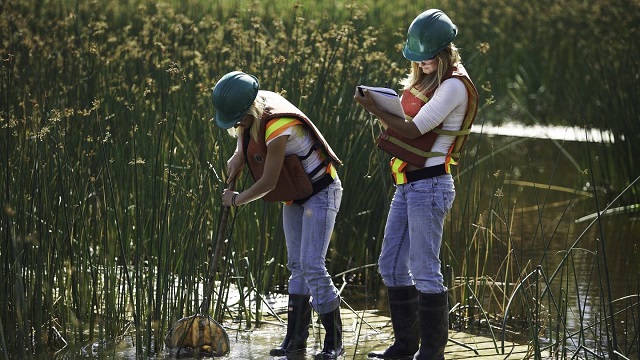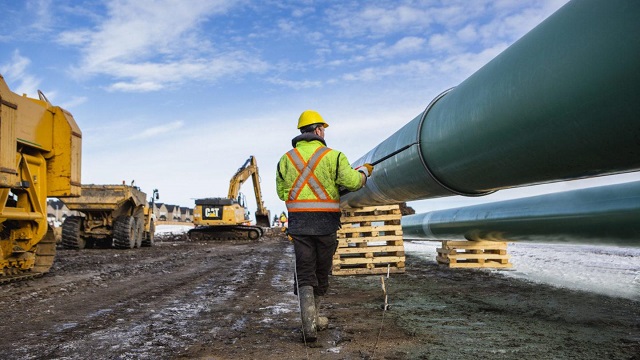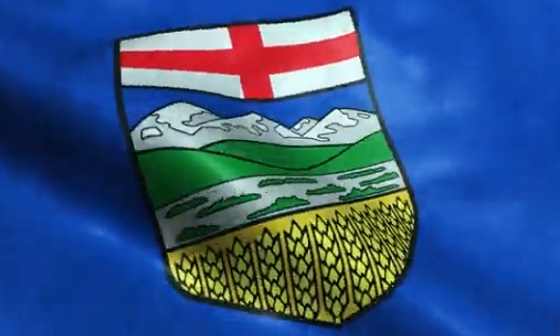Alberta
Wetlands spontaneously forming in oil sands region’s reclaimed boreal forest

Suncor Energy employees monitoring wetlands in the oil sands in northern Alberta. Photo courtesy Suncor Energy
From the Canadian Energy Centre
By Will GibsonWetlands and peatlands are a crucial part of the boreal forest’s ecosystem
A zoologist by training, Jan Ciborowski has spent more than three decades wading through wetlands in the Great Lakes and northeastern Alberta. During that time, he has come to appreciate how nature can change the best laid plans of even the smartest scientists and engineers.
Ciborowski and a team of undergraduate and graduate students are now studying a recently documented phenomenon that highlights nature’s guiding hand: spontaneous wetlands forming in reclaimed areas in the oil sands.
These so-called “opportunistic wetlands” began developing on oil sands sites reclaimed and planted to become forests decades ago at Suncor Energy’s Base Mine and Syncrude’s Mildred Lake Mine north of Fort McMurray.
“Up to 18 per cent of the reclaimed area expected to become forests have seen wetlands spontaneously forming. We are investigating whether they are likely to persist and forecast whether they will be able to sustain themselves,” says Ciborowski, who has held the NSERC/COSIA Industrial Research Chair in Oilsands Wetlands Reclamation at the University of Calgary’s Department of Biological Sciences since 2019.
“We can make forecasts about what will develop over hundreds of years when you reclaim an area but it’s not in our hands. Nature makes those decisions.”
Wetlands and peatlands are a crucial part of the boreal forest’s ecosystem, serving as vital habitat to hundreds of species of wildlife, including waterfowl, songbirds, and mammals such as beaver and moose. They act like sponges, absorbing precipitation and run-off that prevents flooding, and providing water during dry periods to the surrounding upland forests. Peatlands also serve as sinks to store carbon.
Because oil sands companies are legally committed to reclaim their leases to a status equivalent to prior to disturbance, they benefit from wetlands on their reclaimed sites.
The two oldest mining operations — Suncor’s Base Mine and Syncrude’s Mildred Lake Mine — have constructed man-made wetlands on reclaimed sites, where the companies have conducted research.
This is why the presence of opportunistic wetlands, which have been forming on their own, have created a great deal of interest within the industry.
Ciborowski’s team is studying 120 wetlands in the region ranging from two to 40 years of age. Half are on reclaimed oil sands sites and the other half are not.
“These are all very young compared to mature peatlands that have taken hundreds of years to develop. We are monitoring water quantity, water quality, landscape disturbance, and the colonizing plants and animals to understand how conditions develop and to forecast wetlands’ succession,” he says.
Outside of the oil sands, opportunistic wetlands can form when water balances change after forest fires consume the trees, or when beaver activity causes ponds to start forming.
“These can be our frame of reference for comparison with the wetlands forming on reclaimed landscapes. The real challenge is being able to understand whether those wetlands will remain when the trees grow to maturity,” he says.
While it is hard to forecast the future for opportunistic wetlands, Ciborowski has seen how early studies have influenced the science of reclamation and practices within the industry.
“What’s exciting about our work is we’ve gathered experts in a number of different disciplines — hydrology, geosciences, plant ecology, aquatic ecology to name a few — to work together on reclamation science. My belief in research is that collaboration is crucial. One can’t expect to find the necessary breadth of expertise to do it in a single lab.”
Alberta
Alberta government’s pipeline proposal reveals truth nature of oil and gas opponents

From the Fraser Institute
Earlier this month, when Alberta Premier Danielle Smith announced that her government, in conjunction with major players in the oilsands, would propose a pipeline to carry Alberta’s products to tidewater off Canada’s west coast, she may have called the Carney government’s bluff (and the bluff of any other government that might be bluffing about pipelines).
In June, the Carney government passed Bill C-5 to purportedly eliminate the gridlock that prevents the construction of major energy infrastructure. But the government’s first list of projects to get the Bill C-5 treatment did not include any oil or gas pipelines (which was no surprise, in light of Canada’s hostile regulatory landscape that deters private-sector companies from investing time and money). In response to Smith’s announcement, federal Natural Resources Minister Tim Hodgson said any proposal for a pipeline must include “meaningful consultations with Indigenous rights holders” and close partnerships with “all affected jurisdictions.”
Meanwhile, in British Columbia, one of those “affected jurisdictions,” Premier David Eby is essentially denying that Smith’s proposal has significant private-sector support, implying it will require federal spending and that it’s a “direct threat to the kind of economy we are trying to build.” And yet, back in June, Eby said he was open to the idea of another privately-funded pipeline to tidewater in northern B.C., noting only that he doesn’t support “tens of billions of dollars in federal subsidy going to build this new pipeline when we already own a pipeline that empties into British Columbia,” referring to the Trans Mountain pipeline. In other words, it sounds like Eby has changed his tune.
In Quebec, Premier François Legault said in February that his government might be open to a proposed oil pipeline (Energy East) from Alberta—“For the moment, there is no project on the table,” he said. “If there is a project on the table, we will look at it.” Fast-forward to today. When asked about Smith’s proposal, leader of the Bloc Quebecois, Yves-François Blanchet (a close ally of Legault’s), said “Let’s imagine that Quebec is an independent and free country. We will go on the world stage to say that Alberta is destroying the environment of the whole planet.”
Clearly, while the federal government and key provincial governments have implied that they’re open to new pipelines (albeit, under an ever-changing roster of conditions), Premier Smith’s proposal has seemingly revealed the truth. They sound like the same implacable opponents of oil and gas development, in submission to the international climate change movement’s zero-tolerance policy for fossil fuels, that have dominated in Canada for a decade.
Alberta
Sheriffs shut down Olds drug house

News release from the Province of Alberta
The Alberta Sheriffs have shut down a problem property where suspected drug activity threatened nearby playgrounds and other community spaces.
The Safer Communities and Neighbourhoods (SCAN) unit of the Alberta Sheriffs obtained a court order against the property owner of 5222 42 Street. The property will be closed for 90 days, beginning on Oct. 7 at noon. All individuals must vacate the premises, including the property owner.
The community safety order, obtained in the Court of King’s Bench, bars all people from the property until the closure period ends on Jan. 5, 2026, and prohibits certain individuals from accessing the property altogether, while the order is in place. The property will be boarded up, fenced and all the locks will be changed. SCAN members will continue to monitor the property for activity while their investigation remains ongoing. Community safety order conditions remain in effect until Jan. 5, 2028.
“SCAN now adds Olds to the long and growing list of Alberta communities that have benefited from its diligent investigative work. My thanks to members of the southern SCAN unit and the RCMP for the closure of another disruptive problem property that posed a risk to nearby playgrounds and the surrounding community and threatened public safety. Criminal activity has no home in our province. I encourage all Albertans to report suspicious activity where and when they see it.”
“Close collaboration with local police was essential for a successful investigation of this property and I thank the Olds RCMP for its partnership on this file. Residents are relieved to see this property close, putting an end to the illegal activities centred around it. Here and across Alberta, SCAN is dedicated to maintaining the peace and safety of neighbourhoods and communities.”
“Olds RCMP remains fully committed to building safer communities by working in partnership with our community as well as through investigative and enforcement efforts to achieve this goal. Olds RCMP would like to thank the Olds RCMP crime reduction member on conducting an excellent investigation and the Alberta Sheriffs SCAN unit for its assistance during this project.”
The Alberta Sheriffs work with other law enforcement agencies to shut down properties being used for illegal activities. The SCAN unit operates under the Safer Communities and Neighbourhoods Act, which uses legal sanctions and court orders to hold owners accountable for illegal activity happening on their property.
Since its inception in 2008, Alberta’s SCAN unit has investigated more than 10,000 properties and has issued more than 135 community safety orders. Most complaints are resolved by working with owners to stop the illegal activity on their property.
Quick facts
- Between February 2022 and May 2025, the RCMP attended the property 65 times for various types of calls for service.
- The RCMP executed three search warrants between January 2024 and April 2025, during which stolen property, illegal drugs and drug paraphernalia were recovered.
- SCAN investigators and the RCMP continued to receive complaints of suspected drug and criminal activities at the property throughout the course of their investigation and observed activity consistent with drug dealing.
-

 COVID-192 days ago
COVID-192 days agoDevastating COVID-19 Vaccine Side Effect Confirmed by New Data: Study
-

 Red Deer1 day ago
Red Deer1 day agoThe City of Red Deer’s Financial Troubles: Here Are The Candidates I Am Voting For And Why.
-

 Business2 days ago
Business2 days agoTrump and Carney full of warm compliments but still no trade deal between Canada and U.S.
-

 Business1 day ago
Business1 day agoCanada Post is failing Canadians—time to privatize it
-

 Haultain Research2 days ago
Haultain Research2 days agoInclusion and Disorder: Unlearned Lessons from Palestinian Protests
-

 Business1 day ago
Business1 day agoGovernment distorts financial picture with definition of capital
-

 Business2 days ago
Business2 days agoFinance Minister ducks deficit questions, talks down to critics, and rebrands reckless spending as ‘transparency’.
-

 COVID-191 day ago
COVID-191 day agoConservative MP slams Freedom Convoy leaders’ sentencing as ‘political persecution’







